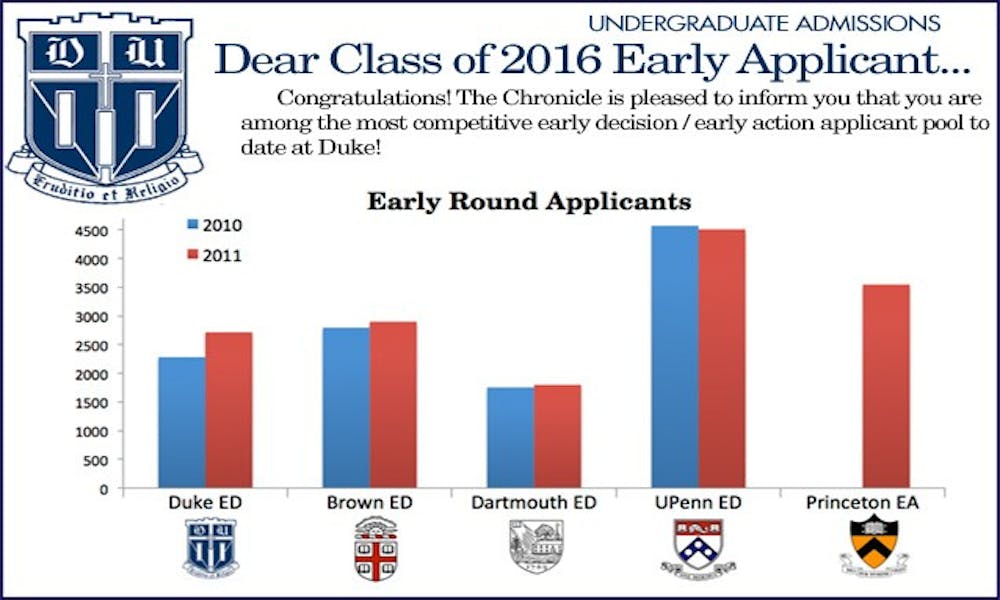More people than ever before are committed to becoming a Blue Devil.
This year, Duke has seen a large increase in binding early decision applications compared to its peer institutions. Although similarly selective universities have also experienced growth—and others have reinstated early action programs—the surge in Duke’s applications remains an anomaly.
The number of early decision applications at Duke increased by 23 percent, from 2,207 last year to 2,716 this year—following the trend the University has experienced in recent years, Dean of Undergraduate Admissions Christoph Guttentag said. Last year, there was a 14 percent increase in early decision applications from the previous year. Applications increased by 24 percent to Trinity College of Arts and Sciences and by 16 percent to the Pratt School of Engineering this year.
Guttentag attributed the rise in early decision applications to the increasingly competitive and selective nature of the college admissions process.
“The increased selectivity of Duke and its peer institutions has injected additional uncertainties into the process,” he said. “Part of what we’re seeing [in the increase] is the desire of the student to bring some clarity to the process earlier.”
Duke in context
In relation to other selective colleges that offer an early binding agreement, Duke enrolls a lower percentage of its incoming class from early decision applicants, Guttentag said. Last year, Duke accepted 29 percent of early decision applications for the Class of 2015.
Several of Duke’s peer institutions saw slight increases in early application numbers. Dartmouth College saw a 3 percent increase from last year, and Brown University saw a 4 percent rise.
The University of Pennsylvania—which enrolls nearly 30 percent of its freshman class from the early decision pool—saw a slight decrease in applications this Fall. This year, they received 4,510 applications, a 1.3 percent decrease from last year. The university’s Dean of Admissions Eric Furda attributed the decline to Harvard University and Princeton University’s return to the early admissions arena, according to a Daily Pennsylvanian article Nov. 10. Princeton received 3,547 applications in its early admissions round, and Harvard has not yet published its early action application numbers.
This year marks the first since 2006 that Harvard and Princeton have accepted non-binding early action applications. Both universities had canceled their early admissions policy four years ago in an effort to make the admissions process more equitable—in hope that peer institutions would follow suit.
Guttentag said the decision for these two universities to reinstate these programs had minimal effect on Duke’s early application process. In the short time period between when Duke’s early decision acceptances are announced and when regular decision applications are due Jan. 2, Guttentag believes that there will be a sharp increase in regular decision applications. He said many will come from students who are rejected or deferred by Harvard or Princeton.
“As we become more and more selective, it gets increasingly more competitive for [the admissions committee] to compete and fight for those students who are also wanted at our peer institutions,” Guttentag said. “As much as prospective students wish to appeal to us, it is our duty to appeal to more and more qualified candidates.”
Behind the surge
The dramatic increase in Duke’s early decision applications is not the result of just one factor.
Provost Peter Lange attributed the surge of applicants in recent years to Duke’s innovative initiatives.
“A big majority of prospective students mention the spirit of initiative of our students in programs, such as DukeEngage, which is indicative of [Duke’s] nature,” Lange said.
Guttentag added that he is pleased that despite the dismal economic situation for many students, families understand that colleges are interested in making education affordable. There was not, however, a significant increase in the percentage of students who indicated that they will be applying for financial aid, he said.
“None of my colleagues perceived the great increase in applications three years ago when the economy slid, so there doesn’t seem to be a perceivable correlation between the state of the economy [and the number of applications],” Guttentag said.
Increases ‘from our own backyard’
Students from North Carolina typically make up a large portion of each class at Duke, and this year, the state also saw the greatest percentage increase in early decision applications—34 percent.
In addition to North Carolina, there were early decision application increases greater than 30 percent in Illinois, New Jersey, Pennsylvania and Washington. Also, 209 international students applied this year—an increase of 8 percent from last year.
“The most surprising percentage comes from our own backyard,” Guttentag noted.
Katherine Cleaver, director of college counseling at Durham Academy, said there has been heightened interest from high school students in North Carolina.
“Duke has worked very hard within North Carolina to increase its visibility and has been very clear in helping students, families and guidance counselors notice the many opportunities for Duke students,” Cleaver said. “North Carolina just has been slower to come to the table to realize that.”
Despite the upswing in applications, Guttentag emphasized that there is still a greater need to appeal to prospective students.
“We attract a very special group of applicants—those that appreciate the strong and rigorous academic and social culture of Duke,” he noted. “And in recent years, the number of such applicants who discover and wish to be part of this special environment have skyrocketed.”
Get The Chronicle straight to your inbox
Signup for our weekly newsletter. Cancel at any time.

